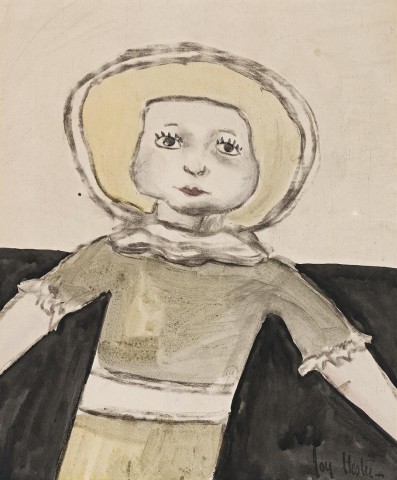DOLL IN GREEN DRESS, c.1947 – 48
JOY HESTER
brush and ink, and watercolour on paper
29.5 x 24.5 cm
signed with estate stamp lower right: Joy Hester
Tolarno Galleries, Melbourne (label attached verso)
Private collection
Niagara Galleries, Melbourne
Private collection, Sydney
Joy Hester, Tolarno Galleries, Melbourne, 6 – 25 October 1976, cat. 30 (as ‘Doll in Green Dress (Sydney Period)’)
Blue Chip III, Niagara Galleries, Melbourne, 27 February – 31 March 2001, cat. 3 (illus. in exhibition catalogue, p.5 and back cover)
Joy Hester was a central figure among the group of artists who gathered around John and Sunday Reed, the enlightened patrons whose home, ‘Heide’, in the rural outer-Melbourne suburb of Heidelberg, offered ‘a vibrant intellectual environment and … haven of shared ideas’.1 A friend and respected peer of artists including Sidney Nolan and Albert Tucker (whom she married in 1941), Hester was a painter and poet whose work was often deeply personal, reflecting aspects of her own life and experience, as well as describing broader human psychology and universally-felt emotions.
Hester’s art is distinguished from that of her male counterparts in that she worked almost exclusively on paper, using brush and ink, watercolour and gouache. While her constant financial difficulty surely influenced this, Hester had a particular facility with these media. Responding to their immediacy, she produced images which appear both spontaneous and intuitive, with a fluidity and lightness of touch that is difficult to achieve in oil paint. Barrett Reid recalled, ‘Joy drew the way other people speak; it was as natural and as simple as that … She worked wherever she happened to be and she happened to be largely amongst people. I can see her now, in this room (the library at Heide) … She’d squat down there, probably smoking cigarettes ten to the dozen, and yapping away like mad. And in front of her would be a whole pile of paper which she’d be drawing on and taking part in the conversation laughing, interrupting, listening intently to what everyone was saying and drawing at the same time’.2
Doll in Green Dress, c.1947 – 48 is an unusual subject within Hester’s oeuvre, and with its sparkling eyes and realistically drawn face, notably different from the expressive and exaggerated features of most of her figures. While the doll’s yellow bonnet has been likened to the stark abstract form of Sidney Nolan’s famous Boy and the Moon, c.1939 – 40 (National Gallery of Australia, Canberra)3, this image is most likely connected to the series of images of Gethsemane – a doll that belonged to Sunday Reed – which Hester painted between 1946 – 47. Following their first meeting at the Herald exhibition of French and British Art in Melbourne in 1939, Hester and Sunday established a lifelong friendship which was as complex as it was steadfast, including an intimate romantic liaison and the Reeds’ adoption of Hester’s son Sweeney in 1949.4 Handmade from linen and filled with lavender from the Heide garden, the faceless Gethsemane represented the children that Sunday was unable to bear and assumed a strong and symbolic presence in her life, familiar to visitors to Heide and featuring in her correspondence with Hester as if she was a real child. While some of Hester’s depictions of ‘Gethie’ (in the collections of the National Gallery of Australia and Heide Museum of Modern Art, Victoria for example), are full of the tragedy of Sunday’s childlessness, others are more optimistic, the prominent eyes a symbol, instead, of the delight and wonder of childhood. It is this sense which Doll in Green Dress reflects, indicative perhaps of the relative stability and happiness of Hester’s life from 1947, when she began a relationship with Gray Smith, with whom she would later have two of her own children.
1. Gellatly, K., Leave no space for yearning: The Art of Joy Hester, exhibition catalogue, Heide Museum of Modern Art, Melbourne, 2001, p. 12
2. Reid, B. quoted in Gellatly, K., ibid., p. 14
3. Blue Chip III, exhibition catalogue, Niagara Galleries, Melbourne, 2001, cat. 3
4. See Harding, L. & Morgan, K., Modern Love: The Lives of John & Sunday Reed, The Miegunyah Press, Melbourne, 2015
KIRSTY GRANT
